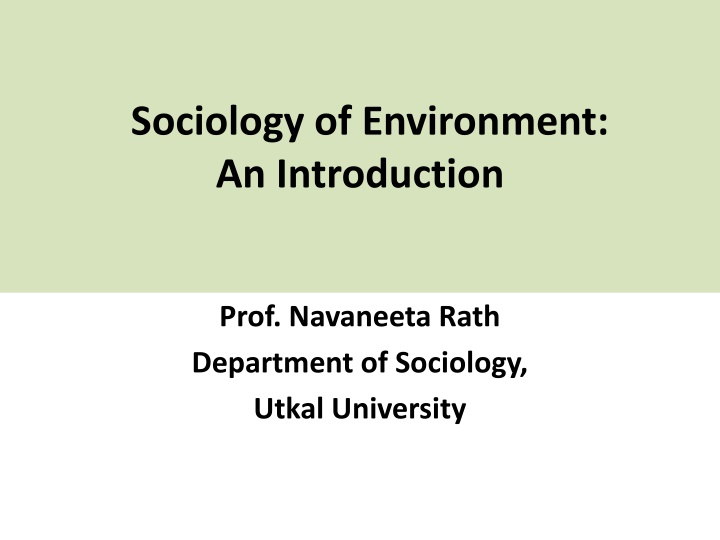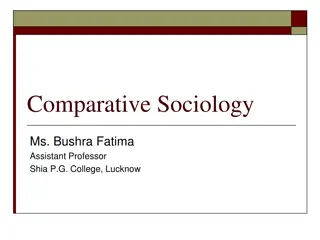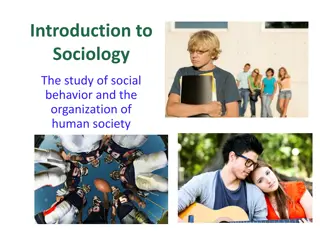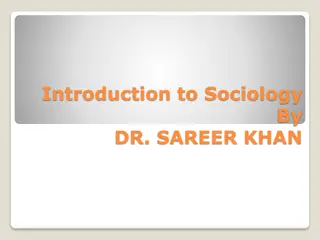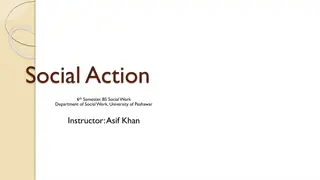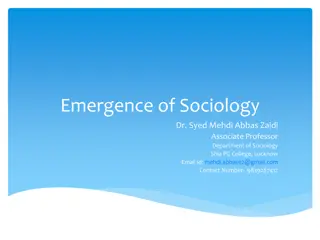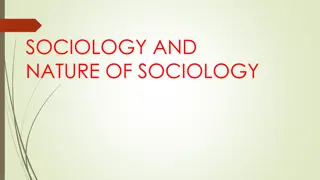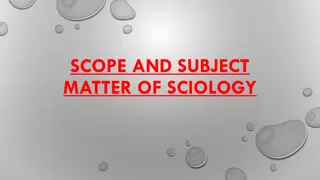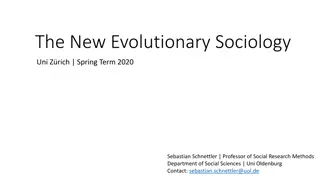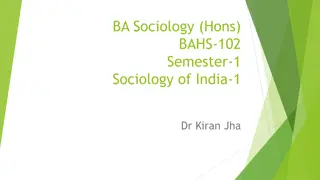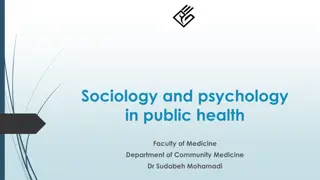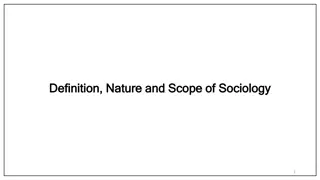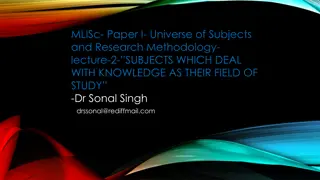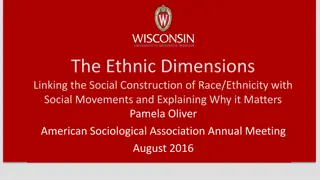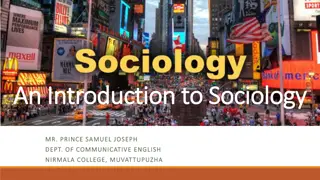Sociology of Environment: Interactions & Movements
Sociology of Environment delves into the dynamic interactions between physical surroundings, societal structures, and human actions, emphasizing the root causes of environmental issues, societal repercussions, and remedial measures. From Classical to Modern sociology, here's an exploration of historical perspectives on human-environment relationships, the emergence of environmental movements, and key contributors shaping the field of environmental sociology.
Download Presentation

Please find below an Image/Link to download the presentation.
The content on the website is provided AS IS for your information and personal use only. It may not be sold, licensed, or shared on other websites without obtaining consent from the author.If you encounter any issues during the download, it is possible that the publisher has removed the file from their server.
You are allowed to download the files provided on this website for personal or commercial use, subject to the condition that they are used lawfully. All files are the property of their respective owners.
The content on the website is provided AS IS for your information and personal use only. It may not be sold, licensed, or shared on other websites without obtaining consent from the author.
E N D
Presentation Transcript
Sociology of Environment: An Introduction Prof. Navaneeta Rath Department of Sociology, Utkal University
Sociology of Environment: Meaning Sociology of Environment studies of the interactions between the physical environment, social institutions and social behavior. Places emphasis on studying the social factors that cause environmental problems, the societal impacts of those problems, and efforts to solve the problems. Aims at understanding environmentalism as a social movement, the ways in which members of society perceive environmental problems, and the origins of human induced environmental decline and unequal distribution of environmental hazards.
Environment in Sociology: Classical to Modern Classical sociology silent about natural environment. Montesquieu and Malthus -the relationship between human societies and the natural environment. Marx, Durkheim and Goldblatt -the relationship between human society and natural environment as central to the historical change, but silent on the issues of economic and demographic impact on environment. Critical theory s assessment of the Enlightenment and modern, industrial societies was the first attempt to systematically analyse the natural environment and its relation to human social practices. Recent theorists Habermas focussed on the problems of nature in Modernity and Gidden s consequences of Modernity work focused on the reciprocal relationship between human societies and natural environments.
Movements and Environment The birth of environmental movement dates back to the publication of Silent Spring by Rachel Carson in 1962The book documented the effect of toxic pesticides on birds and other animals. The hippy movement that developed later in the 1960s was the first large-scale popular subculture to develop themes from environmentalism. In the late 1970s, they called for a new holistic, or systems perspective.
Literature Boom and The Development of Sociology of Environment The works of William R. Catton and Riley Dunlap New Ecological Paradigm(NEP),Ulrich Becks Risk Society, Allan Schnaiberg The Environment from Surplus to Scarcity have been the most influential contributors at the theoretical core of environmental sociology. There is a general agreement that the first explicit use of environmental sociology was by Samuel Klausner in his 1971 book on Man in His Environment. Environmental sociology has now solidified as a respected, interdisciplinary field of study in academia.
Marine biologist Rachel Carson through her book Silent Spring ,in 1962 10 years after, The first report of the Club of Rome on The limits to growth was brought out by an MIT research team coordinated by Dennis and Donella Meadows. Our common future, the final report of the United Nations Commission on Environment and Development, chaired by Gro Harlem Brundtland, published in 1987. Prof. Paul Ehrlich The Population Bomb ,in 1968- PAT formula Ecologist Barry Commoner the Closing Circle It vehemently opposed to industrialization, the exploitation of natural resources and pollution of the environment which would lead to the death of humanity. Yoichi Kaya energy economist,1990 Energy, Environment and Economy
Dimensions How consumption, the economy, technology, and population affect environmental conditions Material How patterns of thought, cultural practices, beliefs, and social experiences affect environmental conditions Ideal Practical What we can do to not only study these problems, but to do away with them
Objectives According to UNESCO (1971), the objectives of environmental studies are: Creating the awareness about environmental problems among people. Imparting basic knowledge about the environment and its allied problems. Developing an attitude of concern for the environment. Motivating public to participate in environment protection and environment improvement. Acquiring skills to help the concerned individuals in identifying and solving environmental problems. Striving to attain harmony with Nature.
Realists say that the objective world is real and independent of our categorizations but filtered through subjective conceptual systems and scientific methods that are socially conditioned . In the realist approach, the problems of the environment are quite real. The task of sociology is to explain the social causes of environmental problems, alternatives to manage environment. Sociologists need to provide a deeper and more systematic understanding of the social roots of environmental problems and the processes of social change. The realist approach : Talk about the social construction of environment. Sociologists need to investigate how the environment is understood by different sections of the population, how environmental issues are constituted as social Problems and how people respond to these discourses of environmental trouble. The Constructivist approach The reformist approach aims to make small reforms to the economic and political structures of current society to deal with environmental problems. A much-read book with this approach is Natural Capitalism. According to Hawken and colleagues, natural capitalism does not aim to discard market economics . Instead what is necessary is the steering of markets in more creative and constructive directions . They suggest for environmental reforms through people s lobby for change, enactment of environmental reforms, responsible citizenship to keep them functioning properly , regulations to prevent environmentally damaging practices, taxes such as a carbon tax on the use of fossil fuels, incentives and subsidies for new technologies such as solar hot water services or wind power. The reformist approach
How Environmental Studies can help? To clarify modern environmental concept like how to conserve biodiversity. To know the more sustainable way of living. To use natural resources more efficiently. To use natural resources more efficiently. To know the behaviour of organism under natural conditions. To know the interrelationship between organisms in populations and communities. To make aware and educate people regarding environmental issues and problems at local, national and international levels.
Part-II&III Environment: Meaning, Components, Relationship between environment and society Environment ethics and environment justice
Environment: Meaning Environment -French word - 'environner - To encircle or surroundings. Environmental Protection Act (1986) defined Environment as the sum total of water, air and land, their interrelationship among themselves and with the human beings, other living beings and property. It can also be defined as external surroundings and conditions which directly or indirectly affects the living conditions or the living organism
It includes biotic factors like human beings, plants, animals, microbes, etc and abiotic factors such as light, air, water, soil, etc
Elements of Environment Physical Biological Cultural
Relationship between environment and society Medicine Food Recreation Industrial product Energy Shelter Nature Society
Four Functions of Environment Protective Functions -protection against soil erosion , droughts , Floods, Noise, Radiations Productive Functions provides various products like, gum resins, medicines, honey, pulp, bamboo, timber, Vegetables and fruits. Regulative Functions -regulates the level of Oxygen and carbon dioxide in atmosphere, temperature. Accessory Function- provides aesthetics, habitat to various flora and fauna besides that it also has an recreational value.
Carnage of Environment Development has always proved detrimental to environment. Trade links, industrialization, colonization, initiation of growth centric development, population explosion, urbanization ,transportation, risky mechanization and globalization have introduced the world with a high velocity economy. But they together have slaughtered the environment and through that have proved to be detrimental to as human health, well-being, and justice. Growth and Green have become counter to each other. Rising standard of living is not pro ecological security.
The Overuse Syndrome Population Exploitation Farming Logging Fishing Tapping Grazing
Instead of becoming complementary economy and environment became counter Growth admits no limit. But ecology demands a limit to growth. Growth changes attitude(unrestricted consumption) and practice of humanity which becomes deterrent to ecological well being. This needs a balancing between consumption and ecological conservatism. There is enough in the world for everyone s need, but not enough for everyone s greed.
Dominant World Views Expansionist Ecological Sustainable Development
Issues of Environmental Justice Environmental Racism Toxic Colonialism
Perspectives to Environmental Ethics Anthropocentrism," or the human- centered approach Biocentrism," or the life-centered approach Ecocentrism," or the ecosystem-centered approach
Reference Books List 1. 2. Dunlap,Riley E. (2001) Handbook of Environmental Sociology, Greenwood 3. Buttel, F.H.(1987) New Directions in Environmental Sociology in Annual Review of Sociology. Vol. 13. pp. 465-488 4. Bell, M.M. (2009)An Invitation to Environmental Sociology. New Delhi: Pine Forge Press 5. Gould, K.A. and T.L. Lewis(2009) Twenty Lessons in Environmental Sociology. New York: Oxford University Press 6.Biswas, Anupama Environment & Society, Wisdom Press (ISBN) (CBCS). 7. Giddens, Anthony (1996) Global Problems and Ecological Crisis : 2nd edition New York. W.W.Norton and Co. Hannigan ,John A. (2006)Environmental Sociology, Routledge
Low Price Books 1. Kaushik, Anubha and Garg ,Gaurav(2018) Perspectives in Environmental Studies, New Age International Publishers(Rs,284/) 2.Bhatacharyya, Sukanta(2014)Environmental Sociology: Indian Perspectives, Levant Books(Rs. 490/)
